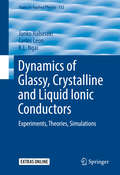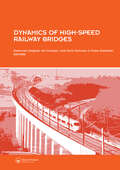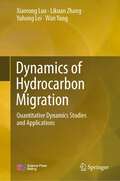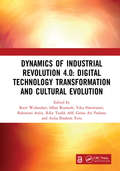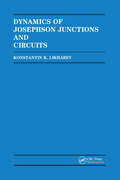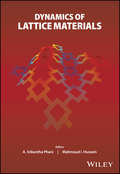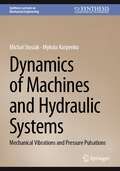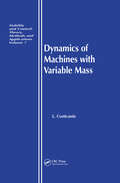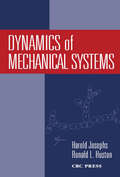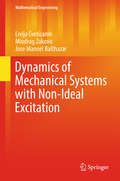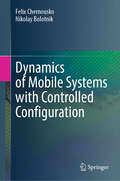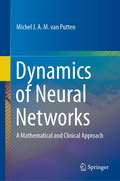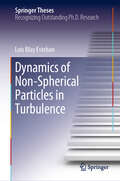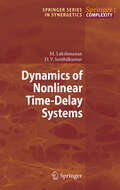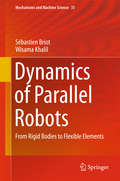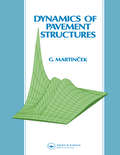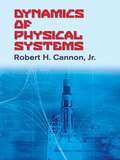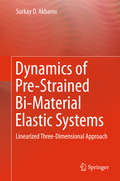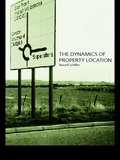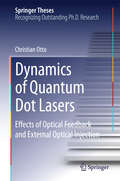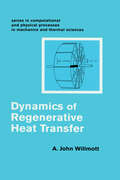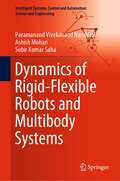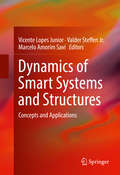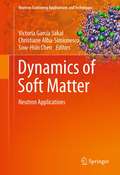- Table View
- List View
Dynamics of Glassy, Crystalline and Liquid Ionic Conductors
by Junko Habasaki Carlos Leon K. L. NgaiThis book discusses the physics of the dynamics of ions in various ionically conducting materials, and applications including electrical energy generation and storage. The experimental techniques for measurements and characterization, molecular dynamics simulations, the theories of ion dynamics, and applications are all addressed by the authors, who are experts in their fields. The experimental techniques of measurement and characterization of dynamics of ions in glassy, crystalline, and liquid ionic conductors are introduced with the dual purpose of introducing the reader to the experimental activities of the field, and preparing the reader to understand the physical quantities derived from experiments. These experimental techniques include calorimetry, conductivity relaxation, nuclear magnetic resonance, light scattering, neutron scattering, and others. Methods of molecular dynamics simulations are introduced to teach the reader to utilize the technique for practical applications to specific problems. The results elucidate the dynamics of ions on some issues that are not accessible by experiments. The properties of ion dynamics in glassy, crystalline and liquid ionic conductors brought forth by experiments and simulations are shown to be universal, i. e. independent of physical and chemical structure of the ionic conductor as long as ion-ion interaction is the dominant factor. Moreover these universal properties of ion dynamics are shown to be isomorphic to other complex interacting systems including the large class of glass-forming materials with or without ionic conductivity. By covering the basic concepts, theories/models, experimental techniques and data, molecular dynamics simulations, and relating them together, Dynamics of Glassy, Crystalline and Liquid Ionic Conductors will be of great interest to many in basic and applied research areas from the broad and diverse communities of condensed matter physicists, chemists, materials scientists and engineers. The book also provides the fundamentals for an introduction to the field and it is written in such a way that can be used for teaching courses either at the undergraduate or graduate level in academic institutions.
Dynamics of High-Speed Railway Bridges: Selected and revised papers from the Advanced Course on 'Dynamics of High-Speed Railway Bridges' Porto, Portugal, 20-23 September 2005
by Raimundo Delgado Rui Calçada José Maria Goicolea Felipe GabaldónThe dynamic behaviour of bridges strongly affects the infrastructure system of high-speed railways, and is a crucial factor in safety issues and passenger comfort. Dynamics of High-Speed Railway Bridges covers the latest research in this field, including: � Recently developed dynamic analysis techniques; � Train excitations;� Design issues fo
Dynamics of Hydrocarbon Migration: Quantitative Dynamics Studies and Applications
by Xiaorong Luo Likuan Zhang Yuhong Lei Wan YangThis book presents the authors' research findings on the dynamics of oil migration, research methodologies, insights and applications in petroliferous basins. It studies the behaviors of oil migration in porous media through physical experiments and numerical simulations, explores the mechanism of oil migration and effects of migration process, and then establishes a migration modeling method by coupling the source, driving forces and carriers. The new method can be used to estimate the amount of migrated hydrocarbons and then predict the location of possible hydrocarbon accumulations in different parts of a basin. This approach is useful for resources assessment and prediction of the distribution of hydrocarbon accumulations. An example utilizing this methodology is presented to study the dynamics of migration and accumulation processes in the southern slope of Dongying Depression in Bohai Bay Basin in China. The book appeals to scientists and professionals working on petroleum prospecting as well as faculty and students in petroleum geology.
Dynamics of Industrial Revolution 4.0: Proceedings of the 7th Bandung Creative Movement International Conference on Creative Industries (7th BCM 2020), Bandung, Indonesia, 12th November 2020
by Ratri WulandariThe 7th Bandung Creative Movement conference presented the theme "Dynamics of Industrial Revolution 4.0" which discussed how the digital world and connectivity changed human culture in various aspects of life, and transformed in accordance to human needs and social culture. Digital technology has transformed society to serve people from manufacturing needs to smart cities, from network connectivity to people connectivity. The application of information technology has helped in improving live quality and environmental sustainability. Digital transformation is revolutionizing how businesses and workers interconnect to be more productive and efficient. The result is improved collaboration, faster processes and time-to-market, lower costs and better products. Devices are getting smarter, meaning they are able to perform more and more tasks without human intervention; moreover, these devices generate data that provide insights to further improve processes and gain greater efficiencies. Moreover, with the Internet of Things (IoT), all these smart devices are interconnected in ways that not only help make them even smarter, but also enhances the intelligence of the overall system. Digital technology is a formidable driver for the transformation of a highly carbon-dependent world into one that is more ecologically ‘smart.’ We are entering a new era of environmental innovation that is driving better alignment between technology and environmental goals. Since its first announcement in 2011, industrial revolution 4.0 has dynamically changed and transformed to adjust itself to the human needs and to serve more efficiency and effectiveness of everyday life as well as environmental enhancement. The 7th Bandung Creative Movement has brought forward discussions on dynamic changes, ups and downs, innovations, relations of industrial revolution of the internet of thing, data, automation, to human physical world, new art and aesthetic, business, product innovation, built environment, and education.
Dynamics of Josephson Junctions and Circuits
by Konstantin K. LikharevThis monograph offers a detailed description of the statistics, dynamics and statics of Josephson junctions. Particular emphasis is placed on the dynamics of new circuits and analog and digital devices using single quanta of magnetic flux.
Dynamics of Lattice Materials
by A. Srikantha Phani Mahmoud I. HusseinProvides a comprehensive introduction to the dynamic response of lattice materials, covering the fundamental theory and applications in engineering practice Offers comprehensive treatment of dynamics of lattice materials and periodic materials in general, including phononic crystals and elastic metamaterials Provides an in depth introduction to elastostatics and elastodynamics of lattice materials Covers advanced topics such as damping, nonlinearity, instability, impact and nanoscale systems Introduces contemporary concepts including pentamodes, local resonance and inertial amplification Includes chapters on fast computation and design optimization tools Topics are introduced using simple systems and generalized to more complex structures with a focus on dispersion characteristics
Dynamics of Machines and Hydraulic Systems: Mechanical Vibrations and Pressure Pulsations (Synthesis Lectures on Mechanical Engineering)
by Michał Stosiak Mykola KarpenkoThe subject of this book is to examine the influence of mechanical vibration on the changes in the pressure pulsation spectrum of hydraulic systems. In book shows that machines and equipment equipped with hydraulic systems are a source of vibration with a wide frequency spectrum. Additionally, hydraulic valves are also exposed to vibration. Vibrations of the substrate on which the hydraulic valve is installed force the control element of the hydraulic valve to vibrate. The control element's vibration produced in this way causes changes in the pressure pulsation spectrum of the hydraulic system. A friction model modified using mixed friction theory can be used for the oscillating motion of the hydraulic directional control spool. Passive vibration isolation methods are proposed to reduce valve vibration. The biomimetic approach can be implemented in hydraulic systems (for pipelines) to reduce mechanical vibration and fluid pulsation. Numerical methods are employed to analyze the effectof changes in the pressure pulsation spectrum on the hydraulic efficiency of the pipelines. Examples are provided for the implementation of numerical methods in the calculation of hydraulic components and systems. Additionally, the effects of energy-saving in hydraulic systems by applying the proposed results overview in the current book. The current book will be interesting for both–scientific and manufacturing staff, since the implementation of knowledge can help to design more substantiable construction of machine hydraulic systems to avoid vibration problems.
Dynamics of Machines with Variable Mass
by L CveticaninDesigned to be a complete and integrated text on the dynamic properties of machines, mechanisms, and rotors with variable mass, this book presents new results from investigations based on the general dynamics of systems with variable parameters. The book considers both weak and strong nonlinear vibrations of these systems, and chaotic phenomena are also discussed. The conservation laws and adiabatic invariants for systems with variable mass are formulated and the stability and instability conditions of motion are defined.
Dynamics of Mechanical Systems
by Harold Josephs Ronald HustonMechanical systems are becoming increasingly sophisticated and continually require greater precision, improved reliability, and extended life. To meet the demand for advanced mechanisms and systems, present and future engineers must understand not only the fundamental mechanical components, but also the principles of vibrations, stability, and bala
Dynamics of Mechanical Systems with Non-Ideal Excitation
by Livija Cveticanin Miodrag Zukovic Jose Manoel BalthazarIn this book the dynamics of the non-ideal oscillatory system, in which the excitation is influenced by the response of the oscillator, is presented. Linear and nonlinear oscillators with one or more degrees of freedom interacting with one or more energy sources are treated. This concerns for example oscillating systems excited by a deformed elastic connection, systems excited by an unbalanced rotating mass, systems of parametrically excited oscillator and an energy source, frictionally self-excited oscillator and an energy source, energy harvesting system, portal frame – non-ideal source system, non-ideal rotor system, planar mechanism – non-ideal source interaction. For the systems the regular and irregular motions are tested. The effect of self-synchronization, chaos and methods for suppressing chaos in non-ideal systems are considered. In the book various types of motion control are suggested. The most important property of the non-ideal system connected with the jump-like transition from a resonant state to a non-resonant one is discussed. The so called ‘Sommerfeld effect’, resonant unstable state and jumping of the system into a new stable state of motion above the resonant region is explained. A mathematical model of the system is solved analytically and numerically. Approximate analytical solving procedures are developed. Besides, simulation of the motion of the non-ideal system is presented. The obtained results are compared with those for the ideal case. A significant difference is evident. The book aims to present the established results and to expand the literature in non-ideal vibrating systems. A further intention of the book is to give predictions of the effects for a system where the interaction between an oscillator and the energy source exist. The book is targeted at engineers and technicians dealing with the problem of source-machine system, but is also written for PhD students and researchers interested in non-linear and non-ideal problems.
Dynamics of Mobile Systems with Controlled Configuration
by Felix Chernousko Nikolay BolotnikThe book discusses the dynamics and control of motion for mobile robots and other systems capable of moving in various environments by modifying their configurations. It is intended for researchers and engineers in theoretical and applied mechanics, robotics, control theory, and biomechanics. Additionally, graduate and post-graduate students studying these disciplines will find it a useful resource.
Dynamics of Multiphase Flows (Cambridge Series in Chemical Engineering)
by Chao Zhu Liang-Shih Fan Zhao YuUnderstand multiphase flows using multidisciplinary knowledge in physical principles, modelling theories, and engineering practices. This essential text methodically introduces the important concepts, governing mechanisms, and state-of-the-art theories, using numerous real-world applications, examples, and problems. Covers all major types of multiphase flows, including gas-solid, gas-liquid (sprays or bubbling), liquid-solid, and gas-solid-liquid flows. Introduces the volume-time-averaged transport theorems and associated Lagrangian-trajectory modelling and Eulerian-Eulerian multi-fluid modelling. Explains typical computational techniques, measurement methods and four representative subjects of multiphase flow systems. Suitable as a reference for engineering students, researchers, and practitioners, this text explores and applies fundamental theories to the analysis of system performance using a case-based approach.
Dynamics of Neural Networks: A Mathematical and Clinical Approach
by Michel J.A.M. van PuttenThis book treats essentials from neurophysiology (Hodgkin–Huxley equations, synaptic transmission, prototype networks of neurons) and related mathematical concepts (dimensionality reductions, equilibria, bifurcations, limit cycles and phase plane analysis). This is subsequently applied in a clinical context, focusing on EEG generation, ischaemia, epilepsy and neurostimulation. The book is based on a graduate course taught by clinicians and mathematicians at the Institute of Technical Medicine at the University of Twente. Throughout the text, the author presents examples of neurological disorders in relation to applied mathematics to assist in disclosing various fundamental properties of the clinical reality at hand. Exercises are provided at the end of each chapter; answers are included. Basic knowledge of calculus, linear algebra, differential equations and familiarity with MATLAB or Python is assumed. Also, students should have some understanding of essentials of (clinical) neurophysiology, although most concepts are summarized in the first chapters. The audience includes advanced undergraduate or graduate students in Biomedical Engineering, Technical Medicine and Biology. Applied mathematicians may find pleasure in learning about the neurophysiology and clinic essentials applications. In addition, clinicians with an interest in dynamics of neural networks may find this book useful, too.
Dynamics of Non-Spherical Particles in Turbulence (Springer Theses)
by Luis Blay EstebanThis book studies the dynamics of 2D objects moving through turbulent fluids. It examines the decay of turbulence over extended time scales, and compares the dynamics of non-spherical particles moving through still and turbulent fluids. The book begins with an introduction to the project, its aims, and its relevance for industrial applications. It then discusses the movement of planar particles in quiescent fluid, and presents the numerous methodologies used to measure it. The book also presents a detailed analysis of the falling style of irregular particles, which makes it possible to estimate particle trajectory and wake morphology based on frontal geometry. In turn, the book provides the results of an analysis of physically constrained decaying turbulence in a laboratory setting. These results suggest that large-scale cut-off in numerical simulations can result in severe bias in the computed turbulent kinetic energy for long waiting times. Combining the main text with a wealth of figures and sketches throughout, the book offers an accessible guide for all engineering students with a basic grasp of fluid mechanics, while the key findings will also be of interest to senior researchers.
Dynamics of Nonlinear Time-Delay Systems
by Dharmapuri Vijayan Senthilkumar Muthusamy LakshmananSynchronization of chaotic systems, a patently nonlinear phenomenon, has emerged as a highly active interdisciplinary research topic at the interface of physics, biology, applied mathematics and engineering sciences. In this connection, time-delay systems described by delay differential equations have developed as particularly suitable tools for modeling specific dynamical systems. Indeed, time-delay is ubiquitous in many physical systems, for example due to finite switching speeds of amplifiers in electronic circuits, finite lengths of vehicles in traffic flows, finite signal propagation times in biological networks and circuits, and quite generally whenever memory effects are relevant. This monograph presents the basics of chaotic time-delay systems and their synchronization with an emphasis on the effects of time-delay feedback which give rise to new collective dynamics. Special attention is devoted to scalar chaotic/hyperchaotic time-delay systems, and some higher order models, occurring in different branches of science and technology as well as to the synchronization of their coupled versions. Last but not least, the presentation as a whole strives for a balance between the necessary mathematical description of the basics and the detailed presentation of real-world applications.
Dynamics of Parallel Robots
by Sébastien Briot Wisama KhalilThis book starts with a short recapitulation on basic concepts, common to any types of robots (serial, tree structure, parallel, etc. ), that are also necessary for computation of the dynamic models of parallel robots. Then, as dynamics requires the use of geometry and kinematics, the general equations of geometric and kinematic models of parallel robots are given. After, it is explained that parallel robot dynamic models can be obtained by decomposing the real robot into two virtual systems: a tree-structure robot (equivalent to the robot legs for which all joints would be actuated) plus a free body corresponding to the platform. Thus, the dynamics of rigid tree-structure robots is analyzed and algorithms to obtain their dynamic models in the most compact form are given. The dynamic model of the real rigid parallel robot is obtained by closing the loops through the use of the Lagrange multipliers. The problem of the dynamic model degeneracy near singularities is treated and optimal trajectory planning for crossing singularities is proposed. Lastly, the approach is extended to flexible parallel robots and the algorithms for computing their symbolic model in the most compact form are given. All theoretical developments are validated through experiments.
Dynamics of Pavement Structures
by Gustav MartincekThis book presents a rigorous treatment of the fundamental, mathematical behaviour of pavement structures under dynamic loading. The topic is of growing importance in economic design of aircraft runways and highway pavements. A range of modelling approaches are presented and compared with experimental data.
Dynamics of Physical Systems (Dover Civil and Mechanical Engineering)
by Dr Robert H. CannonA comprehensive text and reference for a first study of system dynamics and control, this volume emphasizes engineering concepts -- modeling, dynamics feedback, and stability, for example -- rather than mechanistic analysis procedures designed to yield routine answers to programmable problems. Its focus on physical modeling cultivates an appreciation for the breadth of dynamic systems without resorting to analogous electric-circuit formulation and analysis.After a careful treatment of the modeling of physical systems in several media and the derivation of the differential equations of motion, the text determines the physical behavior those equations connote: the free and forced motions of elementary systems and compound "systems of systems." Dynamic stability and natural behavior receive comprehensive linear treatment, and concluding chapters examine response to continuing and abrupt forcing inputs and present a fundamental treatment of analysis and synthesis of feedback control systems. This text's breadth is further realized through a series of examples and problems that develop physical insight in the best traditions of modern engineering and lead students into richer technical ground.As presented in this book, the concept of dynamics forms the basis for understanding not only physical devices, but also systems in such fields as management and transportation. Indeed, the fundamentals developed here constitute the common language of engineering, making this text applicable to a wide variety of undergraduate and graduate courses. 334 figures. 12 tables.
Dynamics of Pre-Strained Bi-Material Elastic Systems
by Surkay D. AkbarovThis book deals with dynamics of pre-stressed or pre-strained bi-material elastic systems consisting of stack of pre-stressed layers, stack of pre-stressed layers and pre-stressed half space (or half plane), stack of pre-stressed layers as well as absolute rigid foundation, pre-stressed compound solid and hollow cylinders and pre-stressed sandwich hollow cylinders. The problems considered in the book relate to the dynamics of a moving and oscillating moving load, forced vibration caused by linearly located or point located time-harmonic forces acting to the foregoing systems. Moreover, a considerable part of the book relate to the problems regarding the near surface, torsional and axisymmetric longitudinal waves propagation and dispersion in the noted above bi-material elastic systems. The book carries out the investigations within the framework of the piecewise homogeneous body model with the use of the Three-Dimensional Linearized Theory of Elastic Waves in Initially Stressed Bodies.
The Dynamics of Property Location: Value and the Factors which Drive the Location of Shops, Offices and Other Land Uses
by Russell SchillerWhy is property located where it is and how has this process changed in recent years? A number of factors such as social change and technological development, have affected location and these are considered. Value, the way changing patterns are measured, is examined and there is a discussion of rent contours. The book considers location in the retail industry, looking at the theory, hierarchy, clustering and dispersal. The move to out of town sites, with its three waves of decentralisation, is described. Central place theory, dating from the 1930s, is discounted as being obsolete and misleading. Finally the book covers offices, industrial and residential property.
Dynamics of Quantum Dot Lasers
by Christian OttoThis thesis deals with the dynamics of state-of-the-art nanophotonic semiconductor structures, providing essential information on fundamental aspects of nonlinear dynamical systems on the one hand, and technological applications in modern telecommunication on the other. Three different complex laser structures are considered in detail: (i) a quantum-dot-based semiconductor laser under optical injection from a master laser, (ii) a quantum-dot laser with optical feedback from an external resonator, and (iii) a passively mode-locked quantum-well semiconductor laser with saturable absorber under optical feedback from an external resonator. Using a broad spectrum of methods, both numerical and analytical, this work achieves new fundamental insights into the interplay of microscopically based nonlinear laser dynamics and optical perturbations by delayed feedback and injection.
Dynamics of Regenerative Heat Transfer
by John A WillmottThe author, a respected authority on heat recovery, provides up-to-date and comprehensive coverage of the modelling of the process of heat transfer embodied in regenerative devices. He brings together material on storage and thermal generators and gives great emphasis to non-linear problems including the representation of temperature dependence of thermophysical properties involved.; In ten dynamic chapters, you will find coverage of: the storage of heat in packing; the Single Blow problem; basic concepts in counterflow thermal regenerators; counterflow regenerators; finite conductivity models; non-linear models of counterflow regenerators; transient response of counterflow regenerators; and parallel flow regenerators. Bringing together material developed over the past twenty years, the book will be of great interest to mechanical and chemical engineers as well as applied mathematicians concerned with models of heat transfer processes.
Dynamics of Rigid-Flexible Robots and Multibody Systems (Intelligent Systems, Control and Automation: Science and Engineering #100)
by Paramanand Vivekanand Nandihal Ashish Mohan Subir Kumar SahaThis book discusses the dynamic analysis of rigid-flexible robots and multibody systems with serial as well as closed-loop architecture. The book presents a formulation of dynamic model of rigid-flexible robots based on the unique approach of de-coupling of natural orthogonal complements of velocity constraints. Based on this formulation, a computationally efficient and numerically stable forward dynamics algorithms for serial-chain and closed-loop robotic systems with rigid or flexible or rigid-flexible links is presented. The proposed algorithm is shown to be a numerically efficient for forward dynamics based on the investigation methodologies built on eigen value analytics. Precision and functionality of the simulation algorithms is presented/illustrated with application on different serial and closed-loop systems (both planar and spatial types). Some of the major robotic arms used to illustrate the proposed dynamic formulation and simulation algorithms are PUMA robot, Stanford robot arm, and Canadarm. It is envisaged that the book will be useful for researchers working on the development of rigid-flexible robots for use in defense, space, atomic energy, ocean exploration, and the manufacturing of biomedical equipment.
Dynamics of Smart Systems and Structures
by Vicente Lopes Junior Valder Steffen Jr. Marcelo Amorim SaviWritten by a team of experts that has been working togetherfor several years in the context of a research network involving internationalinstitutions, this book brings several applications related to smart materialsystems such as vibration and noise control, structural health monitoring,energy harvesting and shape memory alloys. Furthermore, this book also providesbasic knowledge on the fundamentals of smart material systems and structures. Consequently, the present title serves as an important resource for advancedundergraduate and graduate students. In addition, it serves as a guide forengineers and scientists working with smart structures and materials both withan application and basic research perspective. Smart material systems and structures represent a newparadigm which is increasing the capabilities of engineering systems. Adaptability and versatility are some important aspects related to suchsystems. In brief, research on smart materials is characterized by synergisticallycombining different physical features, such as mechanical, electrical,chemical, and magnetic. As a result, smart material technologies have a hugepotential to enhance the performance of engineering structures openingunlimited opportunities to innovation and economic benefits.
Dynamics of Soft Matter: Neutron Applications (Neutron Scattering Applications and Techniques)
by Christiane Alba-Simionesco Sow Hsin Chen Victoria Garcia SakaiDynamics of Soft Matter: Neutron Applications provides an overview of neutron scattering techniques that measure temporal and spatial correlations simultaneously, at the microscopic and/or mesoscopic scale. These techniques offer answers to new questions arising at the interface of physics, chemistry, and biology. Knowledge of the dynamics at these levels is crucial to understanding the soft matter field, which includes colloids, polymers, membranes, biological macromolecules, foams, emulsions towards biological & biomimetic systems, and phenomena involving wetting, friction, adhesion, or microfluidics. Emphasizing the complementarities of scattering techniques with other spectroscopic ones, this volume also highlights the potential gain in combining techniques such as rheology, NMR, light scattering, dielectric spectroscopy, as well as synchrotron radiation experiments. Key areas covered include polymer science, biological materials, complex fluids and surface science.
